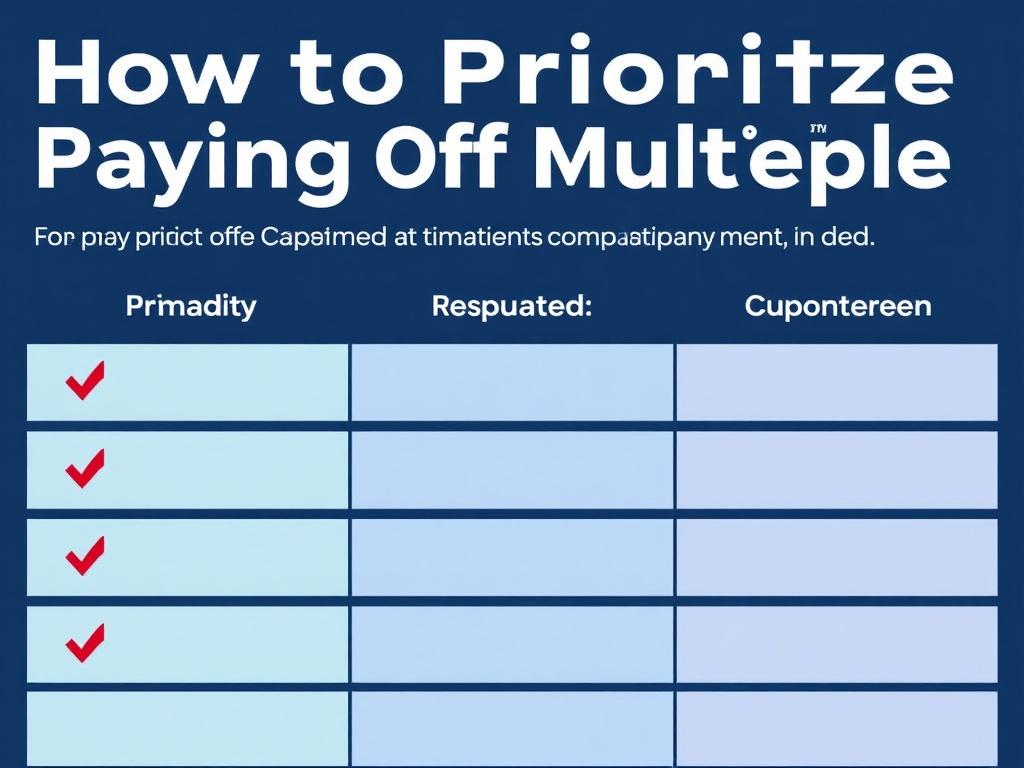SQLITE NOT INSTALLED
Managing debt can often feel like juggling flaming torches while walking on a tightrope — stressful, overwhelming, and sometimes downright scary. When you have multiple debts hanging over your head, figuring out where to start can feel like an impossible task. Should you pay off the smallest debts first, or tackle the highest interest rates? Or perhaps split payments evenly among all your obligations? This comprehensive guide will take you through the ins and outs of how to prioritize paying off multiple debts, helping you take control of your finances and regain peace of mind.
Содержание
Understanding the Importance of Debt Prioritization
Before diving into the strategies for paying off your debts, it’s important to understand why debt prioritization matters so much. Simply paying off debts haphazardly without a strategy can lead to wasted money on interest, missed payments resulting in penalties, and prolonged financial stress. By creating a clear plan, you ensure your efforts are making the most impact, reduce your overall interest burden, and speed up the time it takes to become debt-free. Prioritizing debt doesn’t just improve your financial standing—it improves your mental health and gives you a tangible roadmap toward freedom.
Assessing Your Debt Situation
The first crucial step in learning how to prioritize paying off multiple debts is to get a complete picture of what you owe. Grab all your credit card statements, loan documents, and any other bills. You want to know the following details for each debt:
| Debt Type | Outstanding Balance | Interest Rate | Minimum Monthly Payment | Due Date |
|---|---|---|---|---|
| Credit Card A | $5,000 | 18% | $150 | 15th |
| Personal Loan | $10,000 | 9% | $350 | 1st |
| Store Credit Card | $1,200 | 25% | $50 | 20th |
| Auto Loan | $7,500 | 6% | $220 | 10th |
Write this down or create a spreadsheet to keep all your debts organized. This makes it easier to analyze and decide which debts deserve your immediate attention.
Popular Strategies for Prioritizing Debt Payments
When it comes to how to prioritize paying off multiple debts, there are a couple of widely used methods that many financial experts recommend. Each has its own merits and might fit different financial personalities or situations.
The Debt Avalanche Method
The debt avalanche method focuses on paying off debts with the highest interest rates first while maintaining minimum payments on others. This approach minimizes the total interest paid over time and helps you save money in the long run. Here’s how it works:
- List all your debts by interest rate, starting with the highest.
- Put as much extra money as you can towards the debt with the highest interest rate.
- Continue making minimum payments on all other debts.
- Once the highest interest debt is fully paid, move on to the next highest.
The primary benefit of the debt avalanche is efficiency. You are reducing the cost of your debts faster, which means you pay less overall.
The Debt Snowball Method
The debt snowball method is a psychological approach. It emphasizes paying off the smallest debts first to generate quick wins and build motivation. Here’s the process:
- List all your debts starting from the smallest balance to the largest.
- Pay off the smallest debt first, putting all extra money toward it while maintaining minimum payments on other debts.
- After clearing the smallest debt, move on to the next smallest.
- Repeat until all debts are fully paid off.
While this method may cost more interest in the long run, the psychological boost and momentum it creates can be invaluable for some people.
The Hybrid Approach
If you can’t decide between the debt avalanche and snowball methods, you might try a hybrid approach. For example, start by paying off one or two small debts to gain motivation, then switch to the debt avalanche to save on interest. The hybrid method lets you balance psychology with financial efficiency, tailoring your payoff strategy to your personal preferences.
Other Important Factors to Consider When Prioritizing Debts
In addition to balancing interest rates and balances, several other variables should influence your debt prioritization:
Minimum Payments and Due Dates
Always pay minimum amounts on all your debts to avoid penalties, damage to your credit score, and increased interest rates. Also, try to avoid late payments by keeping due dates in mind. You could even consider aligning your payment dates or setting reminders to make staying current more manageable.
Secured vs. Unsecured Debts
Secured debts (like auto loans or mortgages) have collateral backing them, meaning if you fail to pay, you risk losing the asset. Unsecured debts (like credit cards and personal loans) don’t have collateral but often have higher interest rates. Prioritizing secured debt is important to avoid asset repossession or foreclosure.
Debt That Affects Credit Score Heavily
Some debts may have a more immediate or severe impact on your credit score. Missed payments on credit cards or loans with high balances can ding your credit rating, so consider prioritizing debts to protect your creditworthiness if that is a key concern for you.
Interest Rate Promotions and Penalties
If you have a credit card with a temporary low-interest or 0% APR promotion expiring soon, focus on paying that balance off before the promotional period ends. Conversely, if a loan or card charges heavy penalties or jump in interest rate after a missed payment, prioritize those to avoid additional charges.
Creating Your Debt Payoff Plan
Once you understand your debts and choose a prioritization method, it’s time to create an actionable plan. Follow these steps:
Step 1: Budgeting for Extra Payments
Look at your monthly expenses and income to figure out how much extra money you can put toward debt repayment beyond minimum payments. This might mean cutting discretionary spending, temporarily reducing luxuries, or finding extra income sources like side jobs.
Step 2: Setting Payment Amounts and Dates
Determine how much you will pay toward each debt monthly and set specific payment dates or automate payments to avoid late fees. Consistency is key.
Step 3: Tracking Progress
Keep a debt repayment journal or spreadsheet and update it regularly. Celebrate milestones when debts are paid off to stay motivated.
Step 4: Reassessing and Adjusting
Your financial situation might change through the repayment journey. New income, unexpected expenses, or debt forgiveness might cause you to revise the plan. Flexibility helps maintain progress.
Tools and Resources to Help You Prioritize Debt Payments

Numerous tools can assist you with how to prioritize paying off multiple debts, ranging from free calculators to budgeting apps. Some popular options include:
| Tool | Description | Best For |
|---|---|---|
| Debt Payoff Planner App | A mobile app that helps you plan your debt payments using different strategies. | People who prefer digital tracking and reminders. |
| Bankrate Debt Calculator | Online calculator to simulate payoff scenarios with interest and payments. | Those who want a clear comparison between avalanche and snowball methods. |
| You Need a Budget (YNAB) | Comprehensive budgeting software incentivizing smart money management. | Individuals looking to combine budgeting and debt payoff. |
| Excel or Google Sheets | Customizable spreadsheets to organize and track debts precisely. | People comfortable with spreadsheets who want control over their plan. |
Common Mistakes to Avoid When Paying Off Multiple Debts
While prioritizing debts is critical, certain pitfalls can stall your progress or make the process harder.
- Ignoring minimum payments: Skipping minimum payments can result in late fees and damage your credit.
- Not having a budget: Without tracking income and expenses, it’s tough to consistently pay debts down.
- Taking on new debt: Adding more debt while attempting to pay off existing ones delays your goal.
- Relying solely on credit counseling or consolidation: These options may help but shouldn’t replace prioritization and budgeting.
- Losing motivation after early setbacks: Debt repayment is a marathon, not a sprint; persistence is key.
When to Seek Professional Help
Sometimes the volume or scale of your debts can feel unmanageable no matter what prioritization method you try. In these situations, financial counseling or professional help can be a lifesaver. Certified credit counselors can assess your personal finances, negotiate with creditors on your behalf, or offer debt management plans. Bankruptcy may be a last-resort option, but understanding it and other alternatives from a professional standpoint can clarify the path ahead.
Tips to Stay Motivated Throughout Your Debt Repayment Journey
Paying off multiple debts can take months or years, so maintaining motivation is critical. Here are a few tips to help:
- Celebrate small wins, like paying off a credit card or lowering a balance.
- Create a visual tracker like a debt thermometer or chart you can update.
- Invite a friend or family member to act as an accountability partner.
- Focus on the benefits awaiting you: stress relief, improved credit, and freedom.
- Keep educating yourself on personal finance to stay inspired.
Sample Debt Payoff Prioritization Plan
To put theory into practice, here’s a quick example based on the debts listed earlier:
| Debt | Interest Rate | Balance | Minimum Payment | Priority (Debt Avalanche) |
|---|---|---|---|---|
| Store Credit Card | 25% | $1,200 | $50 | 1 (Pay off first) |
| Credit Card A | 18% | $5,000 | $150 | 2 |
| Personal Loan | 9% | $10,000 | $350 | 3 |
| Auto Loan | 6% | $7,500 | $220 | 4 (Pay last) |
With this plan, you pay minimums on all debts but apply all extra funds to the store credit card first. Once that is clear, move on to the next highest interest debt.
Final Thoughts on How to Prioritize Paying Off Multiple Debts

Figuring out how to prioritize paying off multiple debts can initially feel daunting, but with a clear plan and the right strategy, it’s absolutely achievable. Whether you prefer the mathematical efficiency of the debt avalanche or the motivational boost of the debt snowball or even a hybrid method, what matters most is consistent action. Start by organizing your debts, understanding your budget, and committing to a plan. Use available tools to track your progress, avoid common mistakes, and don’t hesitate to seek professional help if needed. Remember, every dollar you pay down is a step closer to financial freedom. Stick with it, celebrate each milestone, and soon you’ll look back amazed at how far you’ve come.
Conclusion

Prioritizing how to pay off multiple debts requires a thoughtful, well-structured approach tailored to your financial reality and personality. By fully understanding your debts, employing proven methods like the debt avalanche or snowball, and maintaining discipline and motivation, you set yourself up for success. This journey is about more than just numbers—it’s about reclaiming control and reducing stress. No matter where you start, the key is to begin and keep moving forward one payment at a time. With patience, planning, and persistence, becoming debt-free is not just a dream, but a reachable and empowering reality.
Опубликовано: 23 July 2025 Кредитрон – блог о кредитах, финансах и прочих реверансах
Кредитрон – блог о кредитах, финансах и прочих реверансах

